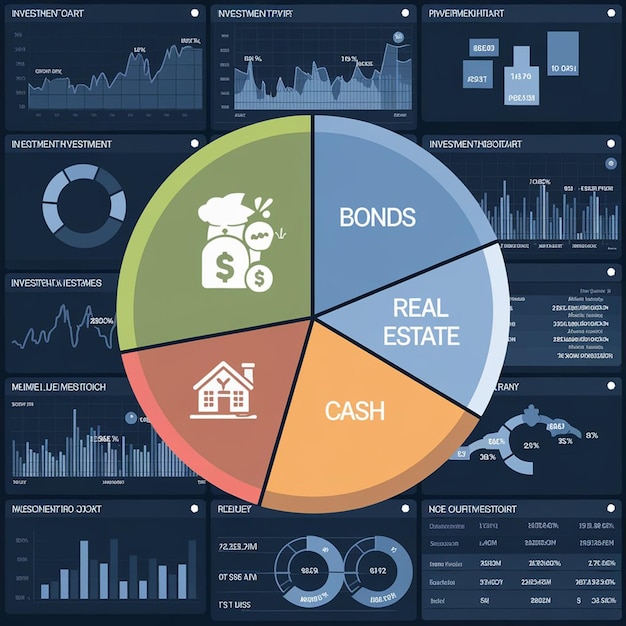Financial Planning 2025: Navigating Inflation with 5 Strategies

Financial Planning in 2025 requires adapting to persistent inflation; key strategies include diversifying investments, focusing on high-yield savings, managing debt wisely, exploring inflation-protected securities, and regularly revisiting your financial plan to adjust to changing economic conditions.
Navigating the financial landscape can feel like charting unknown waters, especially with the ever-present specter of inflation. Financial Planning in 2025: 5 Key Strategies for Navigating Inflation will equip you with the knowledge to not only survive but thrive amidst these economic challenges.
Understand the Inflationary Landscape in 2025
Understanding the economic environment is paramount when making any financial decisions. By 2025, the global economy will likely still be grappling with the aftereffects of recent inflationary surges. Factors include supply chain adjustments, shifts in consumer demand, and evolving monetary policies.
The Persistence of Inflation
Inflation tends to ebb and flows like the tide. However, some economists predict a stickier inflation rate for the coming years. It means that even if the rate of inflation decreases from its peaks, prices will likely remain elevated compared to pre-inflation levels.
Impact on Consumer Behavior
Inflation inevitably changes consumer behavior. As the prices of daily necessities go up, people are forced to re-evaluate their spending habits. Discretionary spending often takes a hit, with consumers prioritizing essentials such as food, housing, and healthcare.

Strategies for Analysis
- Stay informed: Regularly check economic forecasts from reputable sources like the Bureau of Labor Statistics, Federal Reserve, and international financial institutions.
- Analyze your spending: Track where your money is going to identify areas where you can make cuts or adjustments.
- Consider professional advice: Financial advisors can provide personalized insights and strategies tailored to your specific situation.
Consequently, adapting to the inflationary landscape involves being informed, proactive, and strategic in your financial decisions. Staying ahead of the curve allows you to protect your assets and continue making progress toward your long-term financial goals.
Diversify Your Investment Portfolio
Diversification is a foundational principle of sound financial planning, and it’s especially relevant when navigating inflation. Spreading your investments across a variety of asset classes can help mitigate risk and improve returns.
Traditional Asset Classes
Traditional investments typically include stocks, bonds, and cash. Stocks can offer growth potential but also come with higher volatility. Bonds, generally seen as safer, provide a fixed income stream. However, during inflationary periods, bonds might underperform if interest rates rise.
Alternative Investments
Alternative investments can provide diversification beyond traditional asset classes. These include real estate, commodities, private equity, and hedge funds. Real estate, for instance, can act as an inflation hedge, as property values and rents often increase with inflation.

Rebalancing Your Portfolio
- Set target allocations: Determine the percentage of your portfolio you want to allocate to each asset class based on your risk tolerance and financial goals.
- Regularly review: Periodically check your portfolio to see if it still aligns with your target allocations.
- Rebalance as needed: If certain asset classes have underperformed or outperformed, rebalance your portfolio by selling some assets and buying others to bring it back to your desired allocation.
Therefore, diversifying your investment portfolio is not a one-time task but an ongoing process. By adjusting your investment strategy to reflect changing market conditions, you can position yourself to weather inflationary pressures and achieve your financial goals.
Focus on High-Yield Savings Options
In an inflationary environment, the value of cash erodes over time. Traditional savings accounts often offer interest rates that lag behind the inflation rate, resulting in a net loss of purchasing power. Hence, focusing on high-yield savings options can help you offset some of the negative impacts of inflation.
High-Yield Savings Accounts (HYSAs)
HYSAs typically offer more competitive interest rates compared to traditional savings accounts. These accounts are often found at online banks or credit unions, which tend to have lower overhead costs and can pass on the savings to their customers in the form of higher interest rates.
Certificates of Deposit (CDs)
CDs are another option for earning higher interest rates on your savings. With a CD, you agree to deposit a certain amount of money for a fixed period, ranging from a few months to several years. In exchange, the bank offers a higher interest rate compared to regular savings accounts.
Money Market Accounts (MMAs)
MMAs combine features of savings and checking accounts, offering higher interest rates than traditional savings accounts while also providing limited check-writing and debit card access. They can be a good option if you need more liquidity than a CD but still want to earn a competitive interest rate.
In conclusion, by strategically choosing high-yield savings options, you can make the most of your cash reserves and mitigate the negative effects of inflation on your savings. Regularly compare rates and terms to ensure you’re getting the best possible return on your money.
Manage Debt Wisely
Debt management becomes particularly important during inflationary periods. High inflation can lead to rising interest rates, making debt more expensive to repay. Managing your debt wisely can help you avoid financial strain and keep your financial goals on track.
Prioritize High-Interest Debt
Start by identifying any high-interest debt you may have, such as credit card balances or personal loans. These types of debt can quickly become overwhelming due to the high interest rates. Focus on paying off these debts as quickly as possible.
Consider Debt Consolidation
If you have multiple high-interest debts, consider consolidating them into a single loan with a lower interest rate. This can simplify your payments and potentially save you money on interest over time.
Refinance Existing Loans
If you have existing loans, such as a mortgage or student loans, look into refinancing them at a lower interest rate. This can significantly reduce your monthly payments and the total amount of interest you pay over the life of the loan.
- Assess your debt-to-income ratio: Understand how your monthly debt payments compare to your monthly income. A high debt-to-income ratio may indicate that you’re overextended.
- Create a budget: Develop a budget that includes all your income and expenses. Identify areas where you can cut back on spending to free up more money for debt repayment.
- Seek professional advice: If you’re struggling with debt, consider consulting a financial advisor or credit counselor. They can help you develop a personalized debt management plan.
Therefore, managing debt wisely involves being proactive, strategic, and disciplined. By prioritizing high-interest debt, considering debt consolidation or refinancing, and creating a budget, you can take control of your finances and navigate inflationary periods with greater confidence.
Explore Inflation-Protected Securities
Inflation-protected securities are designed to retain their real value. They adjust to changes in the Consumer Price Index (CPI), helping investors maintain their purchasing power.
Treasury Inflation-Protected Securities (TIPS)
TIPS are U.S. government bonds indexed to inflation. The principal of the bond increases with inflation and decreases with deflation, as measured by the CPI. When the bond matures, you receive the adjusted principal or the original principal, whichever is greater.
I Bonds
I Bonds are another type of U.S. government savings bond that are designed to protect against inflation. They earn a fixed interest rate plus an inflation rate that adjusts twice a year.
Beyond government securities, other investments can provide some inflation protection. Here are a few noteworthy options.
Real Estate
As mentioned earlier, real estate can serve as a hedge against inflation. Property values and rental income tend to rise during inflationary periods, offering investors a potential source of inflation-adjusted returns. Owning physical rental properties isn’t the only consideration. Real estate investment trusts (REITs) are another possibility.
Investing in inflation-protected securities can be a smart move to safeguard your portfolio’s real returns. These securities help you maintain your purchasing power and hedge against the erosion of value caused by rising prices.
Regularly Revisit Your Financial Plan
Financial planning isn’t a one-time activity; it’s an ongoing process. The economic landscape changes and evolve, so should your financial strategies adapt accordingly. You should revisit all your assumptions regularly to align with your goals.
Review Your Goals
Start by reviewing your financial goals. Have your priorities shifted? Have you set new objectives for the future? Are you close to achieving your goals?
Assess Your Progress
Next, assess your progress toward your financial goals. Are you on track to meet your targets? Are there any areas where you’re falling behind? Do you need to make adjustments to your savings or investment strategy?
Adjust Your Strategies
Adjust your strategies as needed to align with your revised goals and current economic conditions. For instance, you may need to increase your savings rate, reallocate your investments, or adjust your debt repayment plan.
- Stay flexible: Develop a financial plan that’s flexible enough to accommodate changing circumstances. Be prepared to make adjustments as needed.
- Seek professional guidance: Consider working with a financial advisor who can provide ongoing support and advice. A financial advisor can help you stay on track with your financial goals and make informed decisions.
Regularly revisiting your financial plan is essential for staying on track and achieving your long-term financial goals. By monitoring your progress, adjusting your strategies, and working with a financial advisor, you can navigate inflationary periods with confidence and build a secure financial future.
| Key Point | Brief Description |
|---|---|
| 📈 Diversify Investments | Spread investments across stocks, bonds, real estate to mitigate risk. |
| 💰 High-Yield Savings | Opt for HYSA or CDs to outpace inflation and grow savings faster. |
| 💳 Manage Debt Wisely | Prioritize high-interest debt, consolidate loans, and refinance where possible. |
| 🛡️ Inflation Securities | Explore TIPS and I Bonds to protect against inflation. |
Frequently Asked Questions (FAQs)
▼
Diversify by investing in various asset classes like stocks, bonds, real estate, and commodities to spread risk and potentially improve returns. Consult an expert to fully optimize the diversification.
▼
High-yield savings accounts offer higher interest rates than traditional accounts, helping to offset some of the purchasing power lost due to inflation and sustain your savings’ worth.
▼
Inflation often leads to higher interest rates, making debt more costly. Managing debt wisely helps you avoid financial strain and maintain progress toward your financial goals.
▼
IPS are securities designed to protect against inflation by adjusting their principal or interest rate based on changes in the Consumer Price Index (CPI), safeguarding your investment’s actual value.
▼
You should review and adjust your financial plan at least once a year or when significant life events occur, such as a job change, marriage, or economic shifts, to remain in sync with your needs.
Conclusion
In summary, effective financial planning in 2025 demands a blend of knowledge, strategy, and flexibility to navigate the complexities of inflation. By diversifying investments, maximizing savings, managing debt, exploring inflation-protected securities, and regularly updating your financial plan, you can secure your financial future in an ever-changing economic environment.





